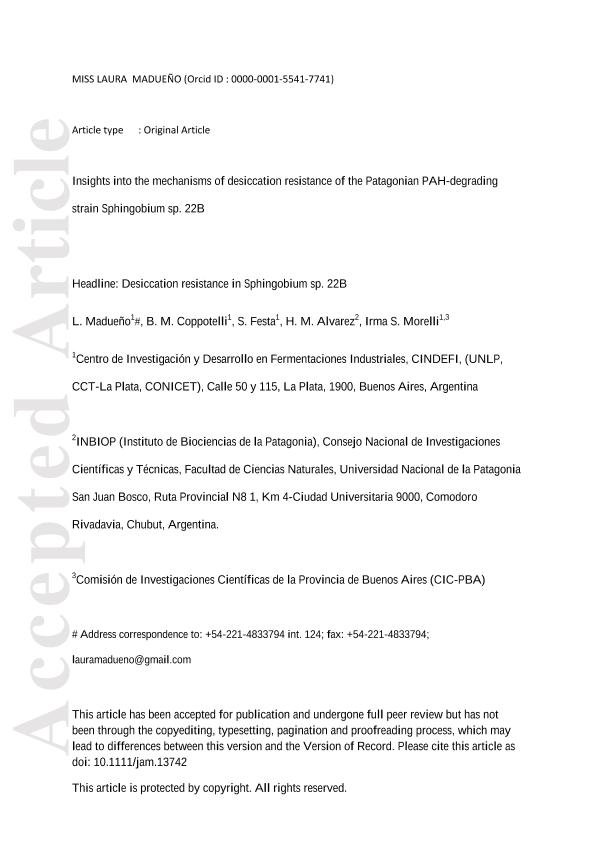Artículo
Insights into the mechanisms of desiccation resistance of the Patagonian PAH-degrading strain Sphingobium sp. 22B
Fecha de publicación:
02/2018
Editorial:
Wiley Blackwell Publishing, Inc
Revista:
Journal of Applied Microbiology
ISSN:
1364-5072
Idioma:
Inglés
Tipo de recurso:
Artículo publicado
Clasificación temática:
Resumen
AimTo analyze the physiological response of Sphingobium sp. 22B to water stress.Methods and resultsThe strain was grown under excess of carbon source and then submitted to low (60RH) and high (18RH) water stress conditions for 96 h. Quantification of trehalose, glycogen, polyhydroxybutyrate (PHB), and transmission electron microscopy (TEM) was studied. Genes linked with desiccation were searched in Sphingobium sp. 22B and Sphingomonas ?sensu latu? genomes and their transcripts were quantified by Real-Time PCR. Results showed that, in absence of water stress, strain 22B accumulated 4.76± 1.41% of glycogen, 0.84± 1.62% of trehalose and 44.9± 6.4% of PHB per cellular dry weight. Glycogen and trehalose were mobilized in water stresses conditions, this mobilization was significantly higher in 60RH in comparison to 18RH. Gene treY was upregulated 6-fold change in 60RH relative to 18RH. TEM and quantification of PHB revealed that PHB was mobilized under 60RH condition accompanied by the downregulation of the phbB gene. TEM images showed an extracellular amorphous matrix in 18RH and 60RH. Major differences were found in the presence of aqpZ and trehalose genes between strain 22B and Sphingomonas genomes.ConclusionStrain 22B showed a carbon conservative metabolism capable of accumulation of three types of endogenous carbon sources. The strain responds to water stress by changing the expression pattern of genes related with desiccation, formation of an extracellular amorphous matrix and mobilization of the carbon sources according to the degree of water stress. Trehalose, glycogen and PHB may have multiple functions in different degrees of desiccation. The robust endowment of molecular responses to desiccation shown in Sphingobium sp. 22B could explain its survival in semiarid soil.Significance and Impact of the studyUnderstanding the physiology implicated in the toleration of the PAH-degrading strain Sphingobium sp 22B to environmental desiccation may improve the bioaugmentation technologies in semiarid hydrocarbons contaminated soils.
Palabras clave:
PAH-degrading Sphingomonas
,
Sphingobium sp. 22B
,
Desiccation
,
Water stress
Archivos asociados
Licencia
Identificadores
Colecciones
Articulos(CINDEFI)
Articulos de CENT.DE INV EN FERMENTACIONES INDUSTRIALES (I)
Articulos de CENT.DE INV EN FERMENTACIONES INDUSTRIALES (I)
Articulos(INBIOP)
Articulos de INSTITUTO DE BIOCIENCIAS DE LA PATAGONIA
Articulos de INSTITUTO DE BIOCIENCIAS DE LA PATAGONIA
Citación
Madueño, Laura; Coppotelli, Bibiana Marina; Festa, Sabrina; Alvarez, H. M.; Morelli, Irma Susana; Insights into the mechanisms of desiccation resistance of the Patagonian PAH-degrading strain Sphingobium sp. 22B; Wiley Blackwell Publishing, Inc; Journal of Applied Microbiology; 2-2018; 1532-1543
Compartir




